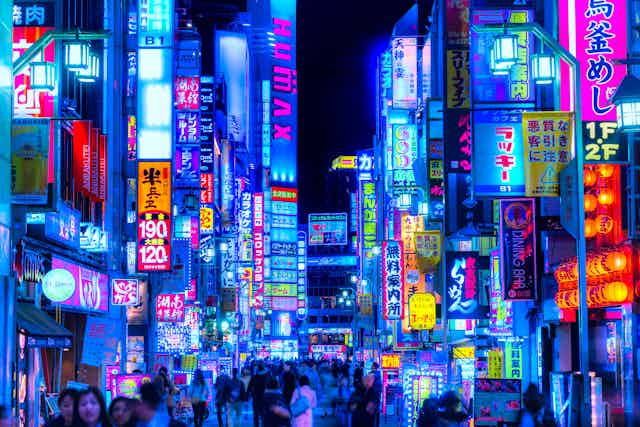Cityscapes have long played an important role in literature. They serve as backdrops for writers looking to explore themes of isolation, destitution, crime and excitement.
In Stephen Crane’s 1893 novel Maggie: A Girl of the Streets, New York City is a constant presence in a family’s struggle with poverty, alcoholism, and a young girl’s fall from grace. Michael Ondaatje’s 1987 In the Skin of a Lion, set in 1930s Toronto, uses the city’s past to expose the controversial history surrounding its construction and the involvement of the migrant population.
While the city is set to remain an important part of fiction, its role is starting to change. Cities are being brought to the forefront as characters in their own right. This use of cities in fiction is an area I am investigating in my PhD research, which explores the use of space in the novels of Japanese author Haruki Murakami.
Giving life to the city
Primarily, the change from the city as a setting to a character is done in one of two ways. The first is to take a posthumanist approach, which gives a kind of artificial life to a city through a combination of technology and machines. The second is a more organic method, which portrays the city as a lifeform able to feel, breathe – and like all organic life, able to die.

Benjamin Oliver’s 2020 debut novel The Loop is an example of the posthumanist approach. It features a technologically enhanced society completely dependent on the city: a sentient creation of machinery and computers.
NK Jemisin’s 2020 novel The City We Became takes a more organic approach in its establishment of the city as a character. In this case, the novel’s cities are alive. They are organisms able to grow, mature, sicken and die. The hum of traffic and the noise of construction is the city’s heartbeat and the sewers its digestive system.
Living Tokyo
Haruki Murakami combines the organic with the posthuman in his 2004 novel After Dark.

The narrator is a machine – a CCTV-style camera, able to move seemingly unhindered throughout the city. The narrator does not reflect on itself but does convey strong feelings as it depicts the events of the novel, leaving us to assume it is some form of artificial intelligence.
The novel, however, begins with this artificial narrator describing the city as akin to an organism: a combination of intertwining organisms connected by numerous arteries which “stretch to the ends of its elusive body, circulating a continuous supply of fresh blood cells”.
The city is a character in its own right. It is a living, breathing entity that sleeps, seemingly unaware of the events and spaces that the protagonist, a young woman named Mari, stumbles into.
After Dark is a story of two sisters who have grown apart. The novel takes place after the last train has left Tokyo, leaving all those remaining in the city trapped until morning. Mari, like many Murakami characters, is unable to find solace at home. Her sister, Eri – a beautiful and popular girl – has withdrawn from society and entered into a state of seemingly unending sleep. Insecurity and guilt over her sister’s current state drives Mari from her family home and into the city.
Despite Mari’s desire to remain an invisible customer of an all-night Denny’s restaurant, she is swept up in the stories of characters who belong to the night. These characters are the embodiment of the city. They are an essential part of its lifeforce, and they are all connected. Each character has “a different face and mind, and at the same time each is a nameless part of the collective entity”.
A mirror to humanity
Murakami’s city is a reflection of his characters. On the surface, the city is a combination of seemingly dark and dangerous places. Yet within its walls are pockets of safety, comfort and human connection. Murakami uses the city to tell the story of those characters who frequent the streets after dark.
Writers like Murakami feel a responsibility to reflect important aspects of society in their fiction – and this is what we are seeing with the changes to the ways writers portray and use fictional cities.

We care about our carbon footprint and about the air our children breathe. So we nurture our cities. We add green spaces, we recycle, walk, cycle, use public transportation. We are proud of our cities and we think of them as a part of our identity. They are an important part of the way we live and we have come to depend on them.
It is no wonder writers are starting to see the city as a living entity. They are bringing the cities to the forefront of fiction and breathing life into them.

